Traditional German Spaetzle Recipe
This post may contain affiliate links. See my disclosure policy.
One of Germany’s most popular and beloved foods, here is a fool-proof and authentic German Spaetzle recipe, just the way my Mutti and Oma made it! Perfect texture and perfect flavor, these are just like you know and love them from the Swabia region of Southern Germany where they originated!
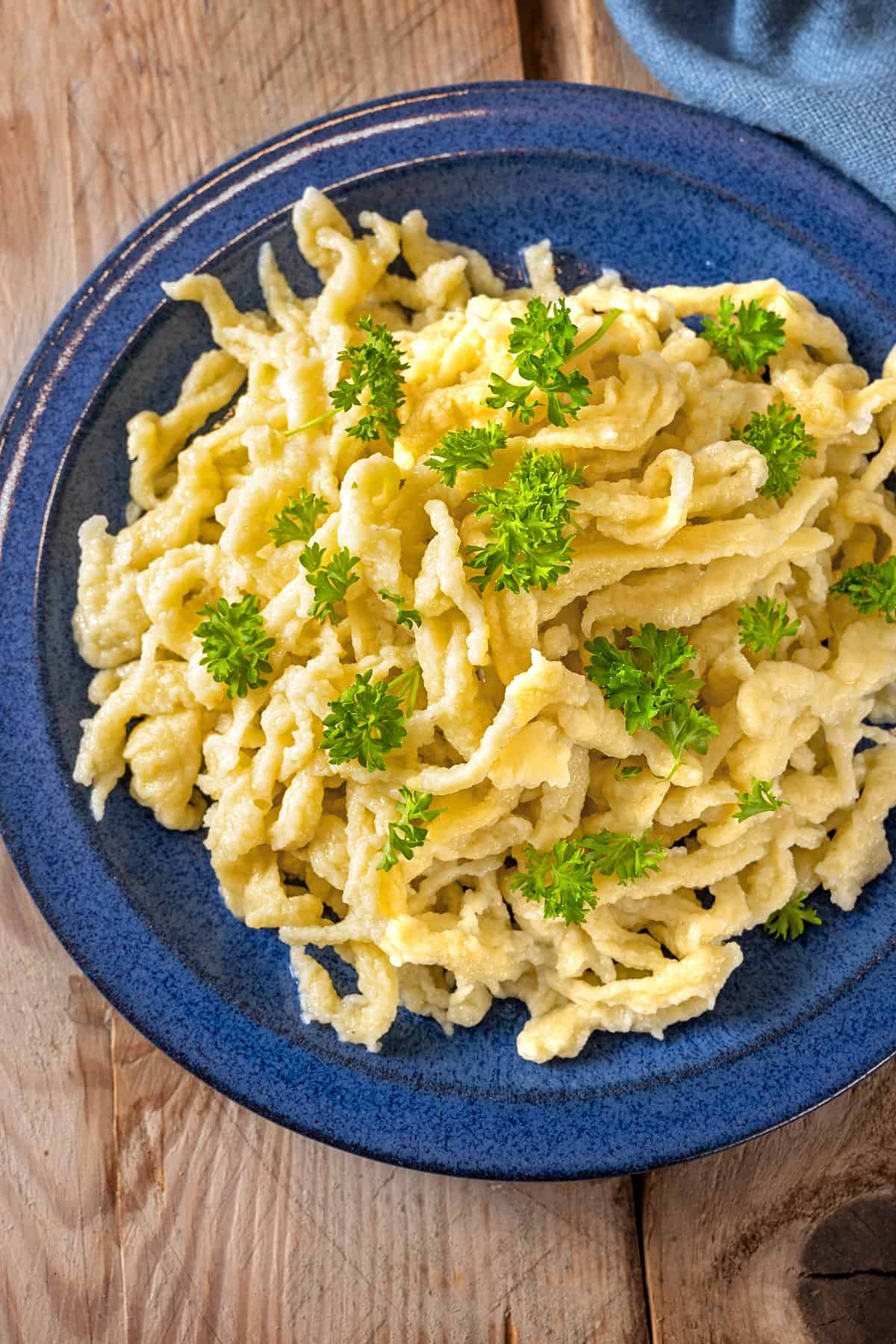
What is Spaetzle?
One of the most beloved foods in Germany that tourists go home talking about is Spaetzle, the famous German egg noodles from the Baden-Württemberg region of southwest Germany. This area is also known as Schwabenland, or Swabia. I grew up in Stuttgart, the capital of Baden-Württemberg, watching my Mom and Oma make Spätzle – I learned from the best!
Swabia is home to some of Germany’s best food (many, including myself, will argue it’s home to the best food in all of Germany). And that’s saying a lot because every region of Germany has amazing food. Swabia is known for its soups, sauces, meats, wursts, and salads, to name a few. It’s also home to some unique varieties of pasta including Spätzle, Schupfnudeln and Maultaschen.
Today we’re featuring Spätzle, a Swabian specialty that is also enjoyed in Austria and Switzerland. Spaetzle is a special type of egg noodle that is enjoyed with sauces and gravies as well as incorporated into a variety of different dishes. One example is Käsespätzle (a cheese spatzle casserole with crispy fried onions). Where did the name “Spätzle” originate? It comes from the German word Spatzen, meaning “little sparrows”, because that’s what they were thought to resemble when they were traditionally made by hand.
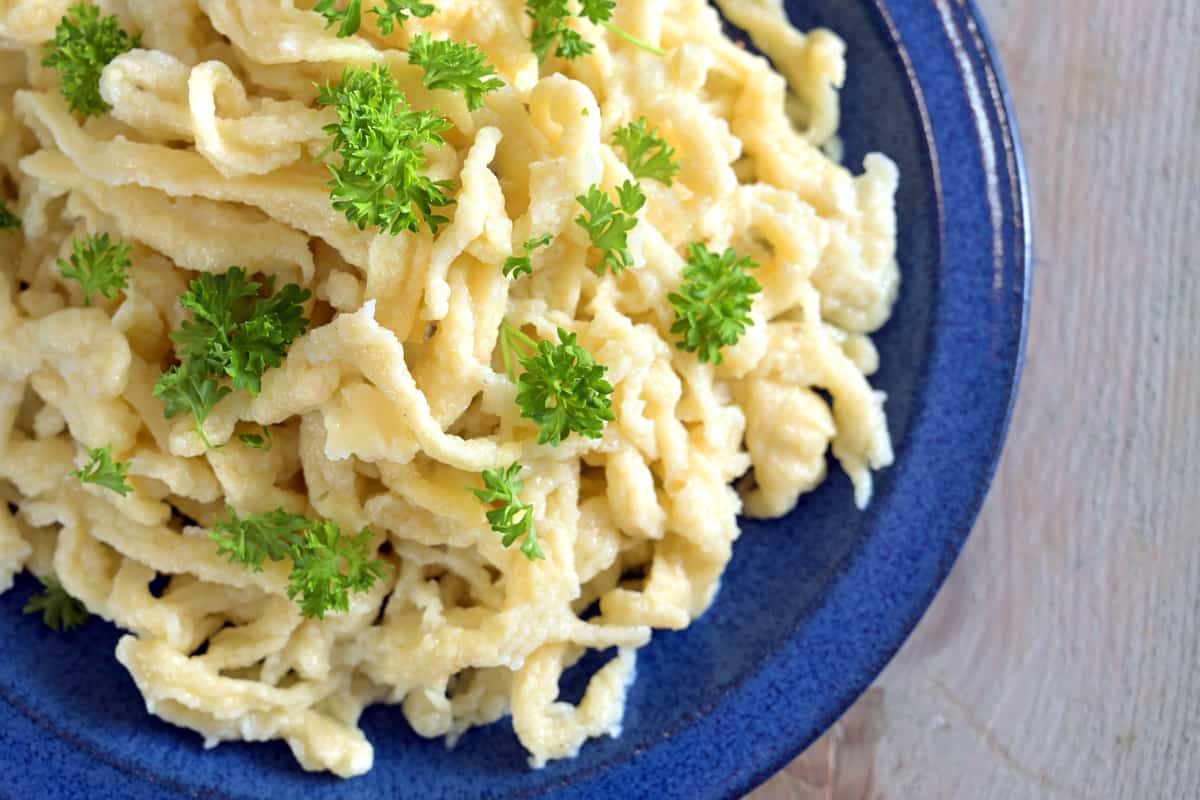
Spaetzle Ingredients
Spaetzle is a type of pasta and as such is made with a very few, simple ingredients that you’ll already have in your pantry. Here’s what you need:
- All-purpose flour: this creates a tender Spaetzle that still has a nice chewy texture.
- Eggs: these add richness and contribute to texture.
- Milk or water: You can use either but I prefer milk as it adds richness.
- Salt: enhances the flavor.
- Nutmeg: this is optional and is not traditional, though many German cooks today like to add it for flavor.
Spaetzle Recipe
Let’s get started!
This spaetzle recipe uses a stand mixer to knead/mix the dough. This is actually the first time I’ve made it that way. I’ve always done it by hand (you “knead” it by vigorously whipping it in a bowl with a spoon – over and over and over for around 20 minutes. It’s a lot of work!) I decided to to try it with a stand mixer instead and it turned every bit as good – and it sure saves a lot of muscle strain!
Add the flour and salt in the bowl of a stand mixer. Stir to combine. Crack four eggs into a bowl and whisk to combine. Make a well in the center of the flour and add the eggs. Add the milk or water and with the paddle attachment (I initially tried the dough hook and it didn’t work well), knead/mix the dough on the “2” setting for about 10 minutes to get a cohesive batter. Add more flour if the mixture is too runny, or more milk if it is too stiff.
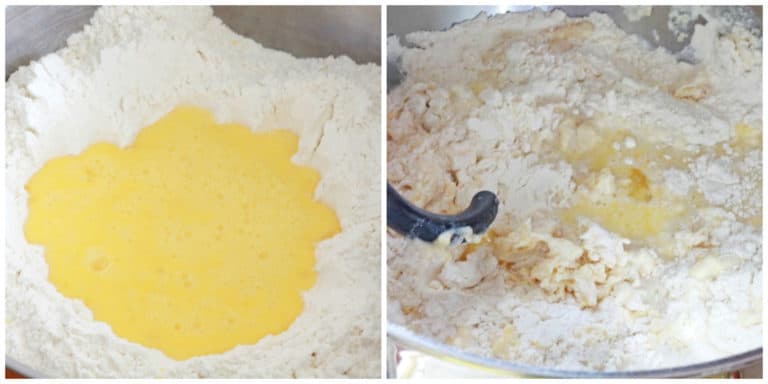
Pro Tip: How to Know When the Spätzle Batter is Ready
The batter is done when “bubbles” begin to form. After about 10 minutes of beating, use a wooden spoon and scoop and pull to stretch the batter; if bubbly holes appear, the dough is done. If not, continue “kneading” with the mixer for another minute or two, repeating the “test” process. See the bubble hole below?
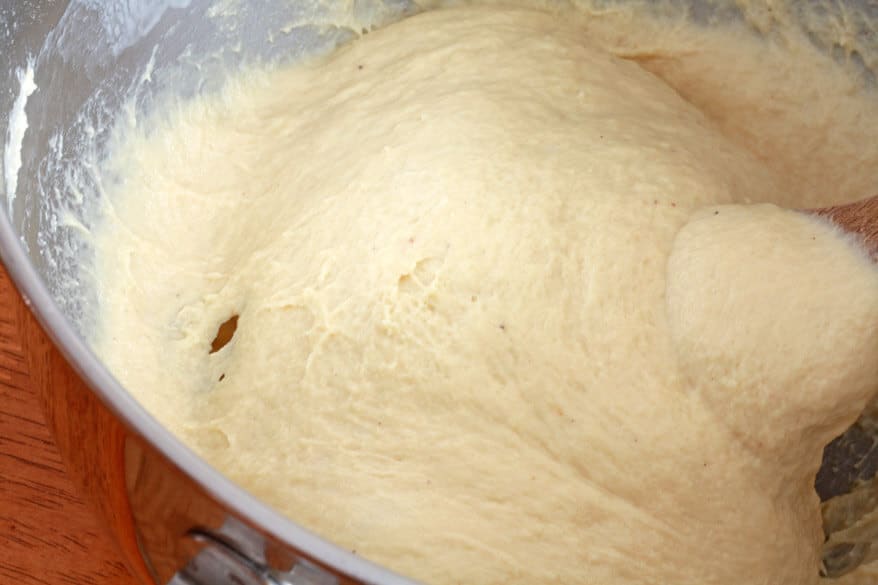
When those bubbly holes start appearing you know your batter is done.
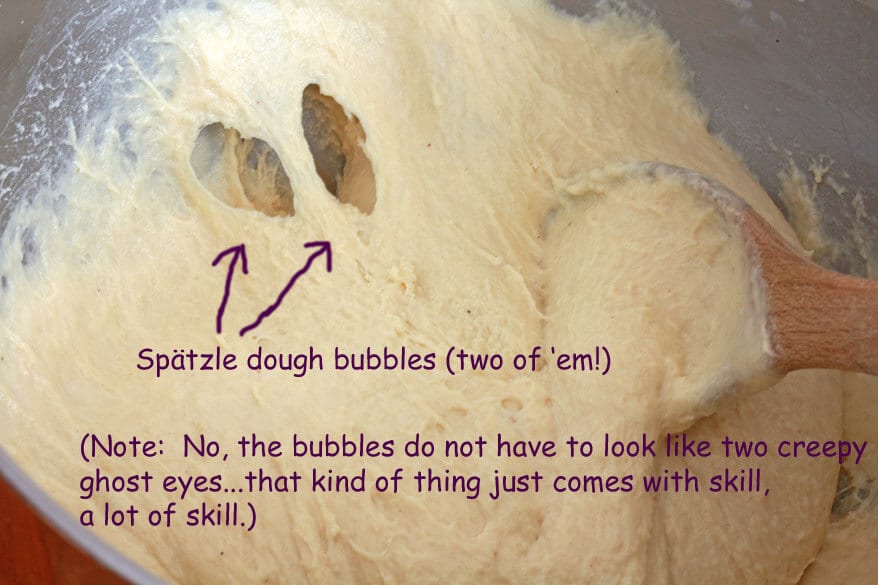
What Is the Best Spätzle Maker?
Now that the batter is read it’s time to make the Spätzle. And when it comes to the Spaetzle maker, there are a few options to choose from. Traditionally, Spätzle was made by hand using a Spätzlebrett, or Spaetzle board. You would rub a slab of dough out onto a wetted board and use a pastry cutter or long sharp knife to quickly cut off strands of the dough into simmering water. Swabian women of previous generations were highly skilled at this and could do it so fast it would make you dizzy to watch. Nowadays most Germans use a Spätzle maker (and even more just buy it ready made at the store. It’s the “convenience generation”).
Besides the traditional Spätzle board there are a few different kinds of Spätzle makers out there that you can find online:
- Spätzle Press (below left): That is my Spaetzle maker that I brought with me from Germany when I moved to the U.S. and it’s awesome. This kind is pricey but it will last a lifetime. It’s called the Original Kull Spätzle Maker and is made in Germany. It’s built like a tank and will become a family heirloom you can pass down for generations. Another brand that is much cheaper and is also made in Germany is this Westmark Spätzle Maker. These Spätzle presses can also be used as potato ricers.
- Spätzle Scraper (below right): Another option is the Küchenprofi Spätzle Lid & Scraper. I’ve used this one as well with good results and it’s much cheaper. It produces a shorter, stubbier spatzle noodle. Alternatively you can also use a metal steamer because it’s similarly constructed with large holes. You place some of the dough in the steamer over the simmering water and scrape the dough through the holes.
- Spätzle Plane: A third option is the Küchenprofi Spätzle Plane with Pusher, which is my least favorite as it can be a little clumsy, messy, and more difficult to work with but I know people who use it.
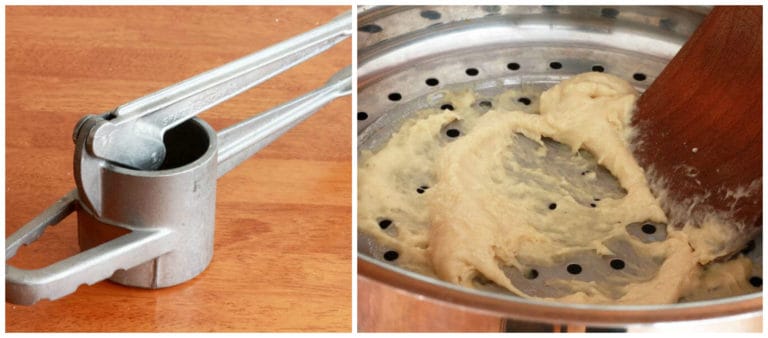
My personal favorite is the Spätzle press and that’s what I’m using in the pictures below. Place the Spaetzle maker over a pot of lightly salted simmering water and scoop some dough into it.
Press the Spätzle maker down to squeeze the Spätzle noodles out into the simmering water. Simmer the Spätzle for about 2-3 minutes or until they float to the top.
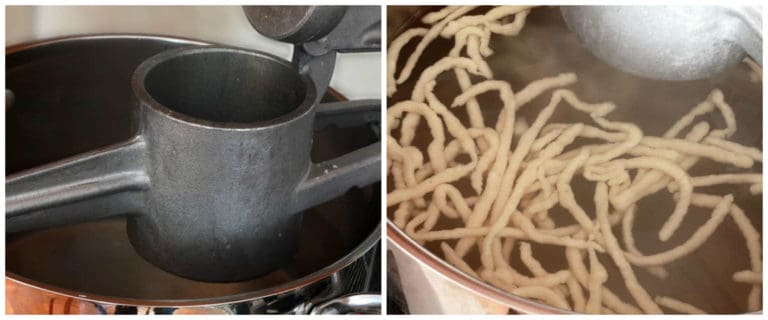
Using a slotted spoon, transfer the Spätzle to a colander and then immediately put them in a bowl of very cold water. This helps them firm up to the desired consistency.
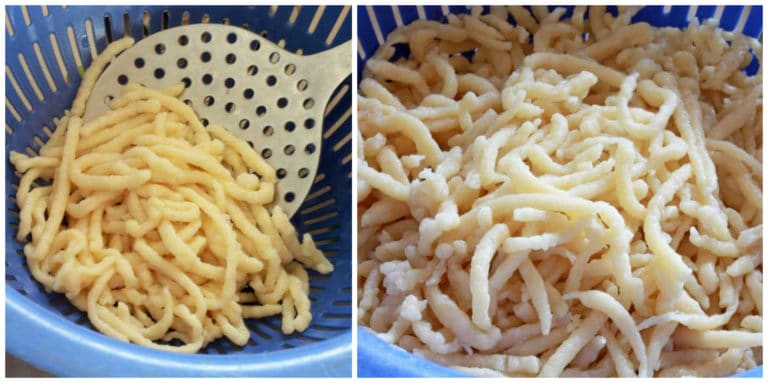
Drain the Spätzle again and toss with a little oil or melted butter to keep them from sticking.
Spätzle will keep in the fridge for at least a couple of days and then heated to serve. Melt some butter in a pan and toss the Spaetzle in it to warm through.
Storage & Freezing
Spaetzle can be made in advance, cooled, and stored in a covered container in the fridge where it will keep for 3-4 days. To reheat it you can microwave it in a microwave-safe container or, my favorite way, is to melt some butter in a large skillet, add the Spätzle and heat through. Spaetzle also freezes well for up 3 months: put it in a freezer-safe container and let it thaw overnight in the fridge. It can be reheated in the microwave in a covered container so that it doesn’t dry out, or you can melt some butter in a pan and toss the Spaetzle in it until warmed through.
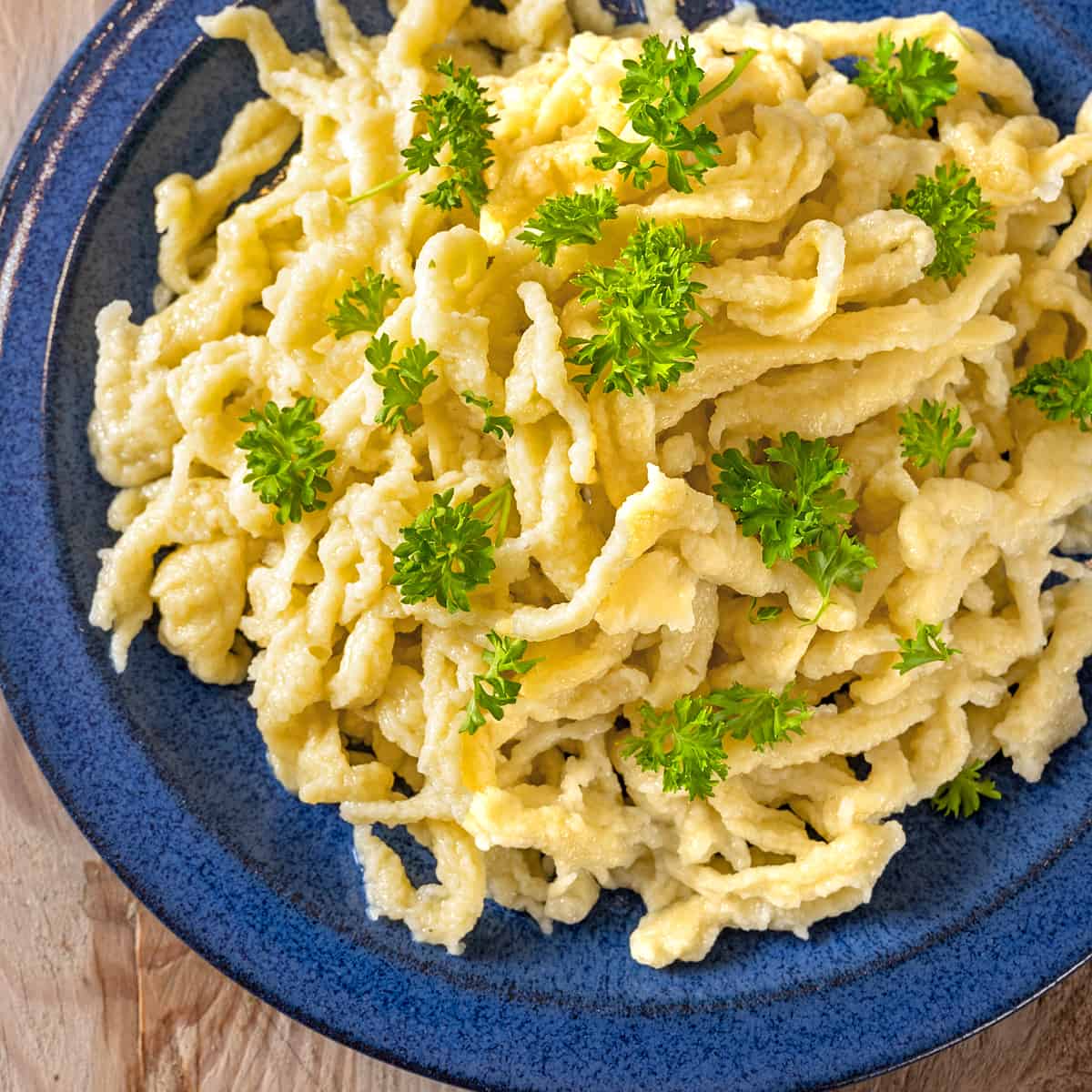
What to Serve with Spaetzle
Spaetzle is very versatile and can be served a variety of ways. Here are a ways to serve spaetzle:
- Buttered Spätzle: This is one of the simplest and most traditional ways to serve spaetzle. After boiling and draining the cooked spaetzle, toss them with melted butter and sprinkle with chopped parsley.
- German Cheese Spaetzle (Käsespätzle): Another Swabian classic and personal favorite, try my recipe for Käsespätzle (pictured below).
- With Sauces and Gravies: Spaetzle can be served with any sauce or gravy, like my favorite German Rahm Sauce, Onion Gravy, or Mushroom Gravy. Serve it with my classic German Goulash, Geschnetzeltes or Königsberger Klopse.
- With Meat Dishes: Spaetzle is the perfect choice to serve with any saucy meat dish like Jagerschnitzel, Rouladen, Sauerbraten, Pot Roast and Tri Tip Roast. It can also accompany your Schweinshaxe and Frikadellen.
- Pasta Salads: For a variation on traditional pasta salad, toss the spaetzle with fresh vegetables, herbs, a vinaigrette, and some diced cheese and ham.
- In Soups: In some regions, spaetzle is added to soups, much like dumplings. Drop small portions of spaetzle dough directly into simmering soup and let them cook until they float to the surface as in this Gaisburger Marsch and German Pea Soup.
Guten Appetit!
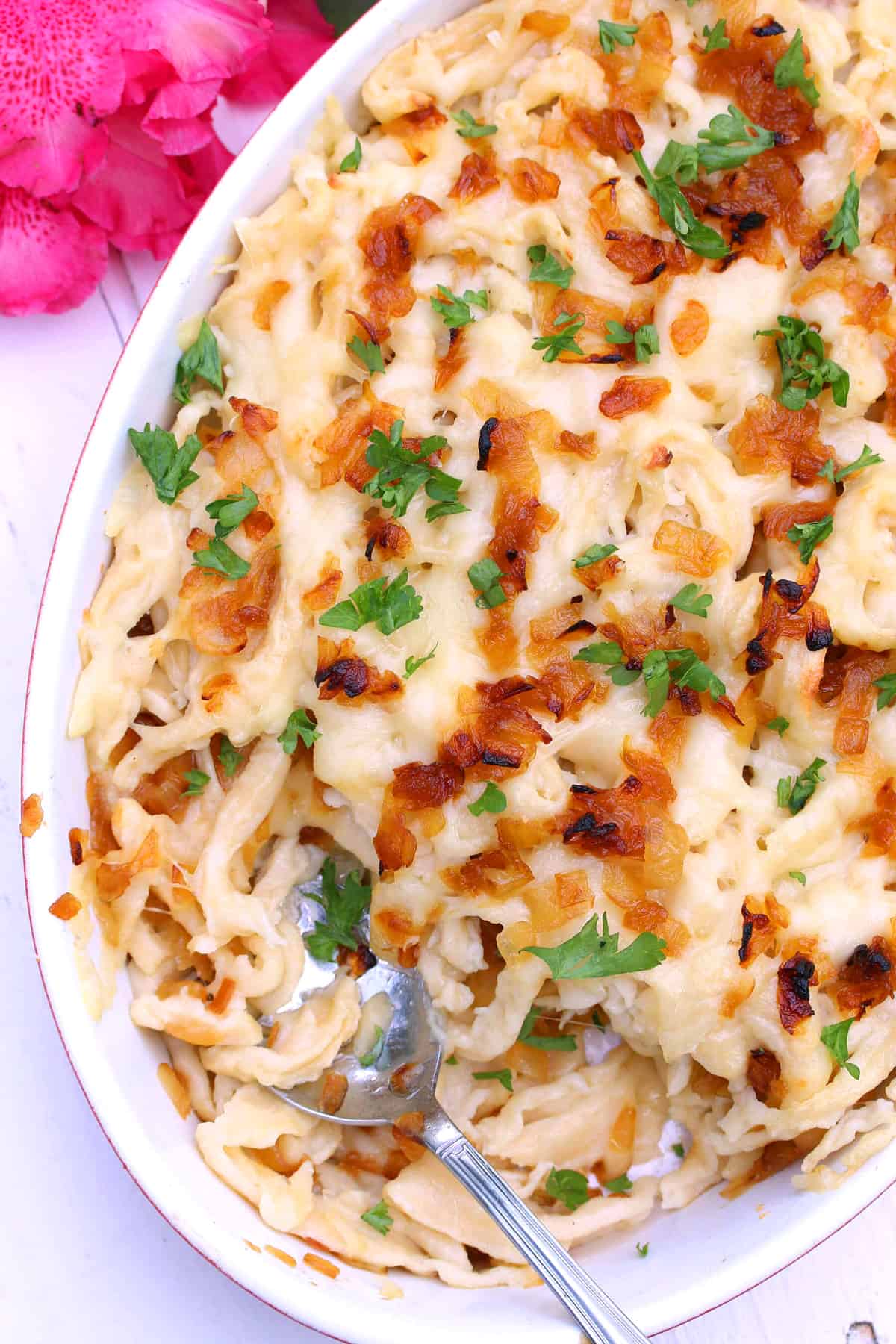
For more favorite traditional German dishes be sure to try my:
- Kaesespaetzle
- Rouladen
- Sauerbraten
- German Goulash
- Maultaschen
- Schnitzel
- Bread Dumplings
- German Potato Dumplings
- Zwiebelkuchen
- German Bread (Vollkornbrot)
- Bratwurst
- Currywurst
- German Potato Salad
- Rotkohl
Save This Recipe
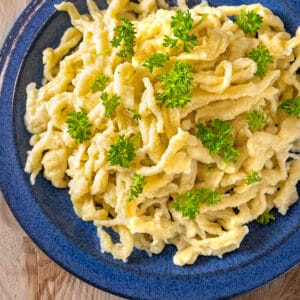
Traditional German Spaetzle Recipe
Equipment
Ingredients
- 2 cups all-purpose flour (you can also use whole wheat flour)
- 1 1/2 teaspoons salt
- 1/8 teaspoon freshly ground nutmeg , optional (not traditional but adds a nice flavor)
- 4 large eggs
- 1/2 cup milk or water + more as needed (milk produces a richer Spaetzle) (**add more flour if the dough is too runny, add more milk or water if it's too stiff)
- butter for serving
Instructions
- The Spätzle batter can be mixed by hand or by using a stand mixer which is much easier. Add the flour, salt and nutmeg (if using) to the bowl of a stand mixer. Stir to combine. Crack the eggs into a small bowl and whisk them. Make a well in the center of the flour mixture and pour the eggs in it. Add the milk (start with using slightly less and add more as needed). Attach a paddle attachment to the stand mixer and "knead" the dough for about 10 minutes or until bubbles appear (see pictured instructions for details). After 10 minutes or so of beating, use a wooden spoon to scoop and pull the dough. If bubbles/holes appear, the dough is done
- Bring at least 2 quarts of lightly salted water to a boil, then reduce to a simmer. Using a Spätzle maker of your choice (I use and prefer the Spätzle press), press the noodles into the simmering water and cook for about 2-3 minutes, or until the noodles float to the top. Use a slotted spoon to transfer the noodles to a colander to drain the hot water and then to large bowl of ice water (this firms them up for a better/chewier texture). After a minute or two transfer them to a colander to drain completely. Before serving, warm them through in a skillet with some melted butter.
- Make Ahead: The Spaetzle can be stored in the fridge for at least a couple of days and then reheated. Melt some butter in a large skillet and toss the Spätzle in it to heat through. Alternatively they can be microwaved in a covered dish.
Notes
Nutrition
Originally published on The Daring Gourmet on August 3, 2013



















What a cool recipe! I LOVE all your photos of Germany! I long to go there one day!
I hope you get to visit, Jaren!
This is so cool! I would love to give this a try someday! :)
For anyone who’s interested in German cuisine, Spätzle is an absolute must, Kristyn!
These pictures are breathtaking! I am dreaming of going to Germany to see these beautiful sites. These homemade noodles sound amazing.
Thanks, Holly, I hope you get to visit someday!
What an informative and great post. I’ve never heard of these before, but they look fun to make. I’ll have to try them out very soon! :)
Cyndi, these are a staple of German cuisine and something every tourist goes home talking about. They are fun to make!
What a beautiful country, and what an awesome food. This spaetzle sounds delicious, and looks so pretty!
Thanks, Cate! I’m obviously biased, but Germany is amazing in every way :)
Does this recipe ever look good! I would never have known what to do so the tutorial is awesome :) Love your photos of Germany and I hope we have the chance to visit one day.
Thanks, Kacey! I hope you do, too. Germany is simply breathtaking – it’s landscapes, architecture, culture, traditions, and of course its food!
I discovered spaetzle yesterday, and made them this morning. OMG! I made them with water, no milk. And I added spinach powder. Now I’m sitting down to a bowl of fried onion, spaetzle and cheese. It’s winter here, and boy, am I comforted!
I didn’t have a potato ricer, and didn’t have a knife suitable for the board method, or a colander with a flat bottom.
did have a flat grater with large square holes, so I used my fingers to push the dough through the back of the grater…. perfect! And no monetary outlay, even better.
Yum!
Yayyy! I’m so happy you discovered Spaetzle, Gloria! It’s one of my favorite things and I agree, the shape is pretty irrelevant – it’s the texture and flavor that makes it so wonderful. Thanks for the feedback!
What a beautiful site.
Thank you, Katherine! :)
I loved this spaetzle! I had to make do with slapping some dough on a wet cutting board, then cutting/scraping a strand of dough with my dough scraper, then cutting the strand again diagonally, but that actually worked pretty well! I had some spaetzle once in Hungary that had come up in conversation and left me craving spaetzle, and the thicker chunks produced by my method were probably closer to what I remembered. I used a bit less milk to keep the dough more workable on the board.
Oh, and I used your Hungarian mushroom pasta, substituting half shitake mushrooms, since I didn’t have enough crimini. The sauce was out of this world! My wife and I both lapsed into silence as we started eating, it was so good! I will make both of these again, and I think the soup version of the mushroom pasta needs a try, too! Thanks for sharing these delicious recipes!
Hi Steve! I’m absolutely thrilled that you and your wife enjoyed the Spaetzle and Hungarian Mushroom Pasta! Yes, it Hungary they make the Spaetzle by leaving the dough in a clump and pinching off chunks with their fingers into the water, so they’re shorter and and stubbier. In Germany they use that method as well and they’re called Knoepfle. Same batter, just different shape. Thank so much for your feedback, Steve, I really appreciate it! Best, Kimberly
I’ve been making Spaetzle for years. My Grandma Ische taught me how when I was young! I use spaetzles instead of noodles in my soups. I make the dough and take a tsp with a little of the dough and add it to the soup while it’s simmering. The noodles look like little dumplings when they rise to the surface! They are so chewy and very good. My husband loves this better than noodles.
Hi Kelly! Absolutely, that’s a popular way to use the Spaetzle dough for soups in Germany. You’ll see that very method used in my German Pea Soup recipe. That’s great that you’ve carried on the tradition that your grandma taught you. Happy cooking!
Well, I just tried this recipe and I have to say, the end result is very good.. I really had a heck of time with the dough, got pretty frustrated. The dough (made according to the recipe) was very thick and very heavy, even after thinning down with more milk. Is the dough supposed to be so thick?? If it is, I wish the recipe would state that, so I would know if I was doing it right, or messing it up completely. I have seen other recipes where the dough seems definitely wetter .. it didn’t know if it was supposed to pass through the spaetzel maker freely, or if you would have to use brute force to get it through the machine. Could you please clear up the dough consistency in the recipe. Will I make it again .. now that I know what is involved, I will make it again, but because of how fussy it was to work with I will do it only ahead of time, not a last minute dinner idea. When done, though, it was very good….
Hi Lorna, thanks for your feedback and I’m sorry you had such a wrestle with the dough. How much additional milk did add? Without actually seeing your dough it’s hard for me to know just how thick it was. I can tell you though that no, the dough is not supposed to be very wet or runny. It’s a thick batter and does require a lot of arm strength if you’re beating it by hand. When using the Spaetzle press I have to press down quite hard, using both hands and using some of my body weight. You want to dough to be like this for better results – instead of being limp and soft like very wet dough would produce, the Spaetzle will have some “bite” and chewiness to them, which is how they should be.
Hi Kimberly, I’m looking to try this recipe out tomorrow. I’m wondering two things… Is using a stand mixer necessary? (laziness asking, I don’t want to dig mine out) And do you think a potato ricer would do the trick in place of a spaetzle maker? They look kind of the same. Thanks!
No, a stand mixer is not necessary at all, in fact I never used mine for that purpose until more recently – out of laziness :) It’s hard work beating the dough non-stop by hand for a solid 15 minutes or so! I have not personally used a potato ricer since I have my beloved Spaetzle press, but yes, potato ricers are commonly used for that purpose over here. It simply yields a different shape but same flavor and texture. Happy eating!
be easy on yourself.. making these babies. 3/4 all purpose unbleached flour, 1/3 c. water, 1 egg. can triple this for more. consistency, heavy stirring till smooth, yeasty feeling, elastic, thick. use a tsp spoon tip, make small, dip into boiling water, sinks, done when come to top, strain, add butter, DONE. Quick method from my European G’ma. never used spatzle maker in my life. These are good & easy, use with Hungarian paprikash, gravy.
Thank you so much for your beautiful site. I made the spaetzle from your recipe and my Danish husband almost fainted. It will definitely become a regular recipe for us. I am now making your chicken with the bacon and cream sauce and seeing if I can get him, the pickiest eater I have ever met, to eat mushrooms without noticing. I choped them in such a way that he can’t tell. Your recipes are wonderful. I have given up on many blog recipes because they aren’t great. But your adaptations of classics are perfect. Gulyas is next which I have made before, but your recipe looks much easier. We are going to get fat and happy!
Thank you, Talia, you’ve made my day :) I really appreciate your kind words, compliments and feedback. I’m thrilled you’re enjoying the recipes. Happy Cooking and let us know how the Smothered Chicken goes!
I’m liking your German recipes. I’ve had the Swabian cheese spaetzle that a friend made in Germany, and it was fabulous! Do you think a potato ricer would work to make the spaetzle? Thanks.
Thanks, Vicky! Yes, you can use a potato ricer. Each gadget produces a little different shape and it all comes down to personal preference. And in the end, it all tastes the same! :)
Thanks for that Kim, I would like to conquer the art of the machine! However today we will have Laugen Praetzlen, yes i have conquered that art. I have baked my own bread now for the last 50 Years as I lived in your name sake area of W.A The Kimberly – in the most remote places there – so no bakeries or shops that cater for the Schwaebisch palet. So you learn to garden and bake cook etc.
That’s wonderful, Margarete. We have everything easily accessible here (even a German deli) but we still have a garden each year and I love to do canning, bake my own bread, etc. Nothing beats homemade bread. I’d love to try your Laugenbrezel! Greetings to The Kimberly, Australia! :)